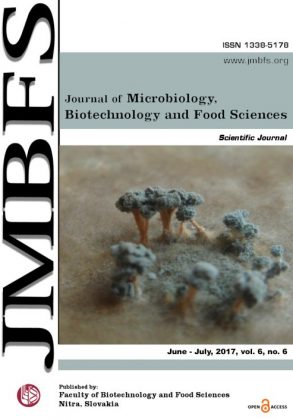IN VITRO EFECTS OF SELECTED BIOLOGICALLY ACTIVE COMPOUNDS ON RABBIT SPERMATOZOA MOTILITY BEHAVIOUR
DOI:
https://doi.org/10.15414/jmbfs.2017.6.6.1290-1294Keywords:
Spermatozoa, rabbit, resveratrol, quercetin, curcumin, epicatechin, isoquercitrinAbstract
The aim of this study was to evaluate the in vitro effects of selected pure naturally occuring biologically active compounds (resveratrol-RES, quercetin-QUE, curcumin-CUR, epicatechin-EPI, isoquercitrin-ISO) on rabbit sperm motility using the IDENT staining method and the computer-aided sperm (CASA) analysis. Semen samples were collected regularly from 10 male rabbits, pooled, the seminal plasma was removed and the sperm fraction was exposed to different concentrations (1, 5, 10, 50 and 100 μmol/L) of chosen biomolecules. At culture times of 0h, 2h, 4h, 6h and 8h, the spermatozoa motility was assessed using the TOX IVOS II. CASA system and the IDENT fluorescent staining method. The motility assessment revealed different behavior patterns, specific and unique to each of the studied biomolecules. After 8h of in vitro culture, the highest sperm motility was detected in experimental groups subjected to 10 μmol/L RES (P<0.05); 1-10 μmol/L QUE (P<0.01 with respect to 1 μmol/L QUE; P<0.001 in case of 5 and 10 μmol/L QUE); 1 μmol/L CUR (P<0.01); 1-100 μmol/L EPI (P<0.01 in relation to 50, 10 and 5 μmol/L EPI; P<0.001 with respect to 100 and 1 μmol/L EPI) and 10 μmol/L ISO (P<0.05) when compared to the untreated Control. Our data provide evidence on specific toxic and beneficial concentrations as well as exposure periods applicable for each biomolecule, which may be useful for future in vitro farmagological or toxicological studies on male reproduction in rabbits.Downloads
Download data is not yet available.
Downloads
Published
2017-06-01
How to Cite
ÄŽuraÄka, M., Halenár, M., & Tvrdá, E. (2017). IN VITRO EFECTS OF SELECTED BIOLOGICALLY ACTIVE COMPOUNDS ON RABBIT SPERMATOZOA MOTILITY BEHAVIOUR. Journal of Microbiology, Biotechnology and Food Sciences, 6(6), 1290–1294. https://doi.org/10.15414/jmbfs.2017.6.6.1290-1294
Issue
Section
Biotechnology
License
Copyright (c) 2017 Michal ÄŽuraÄka, Marek Halenár, Eva Tvrdá

This work is licensed under a Creative Commons Attribution 4.0 International License.
All papers published in the Journal of Microbiology, Biotechnology and Food Sciences are published under a CC-BY licence (CC-BY 4.0). Published materials can be shared (copy and redistribute the material in any medium or format) and adapted (remix, transform, and build upon the material for any purpose, even commercially) with specifying the author(s).





